Ask A Researcher
July 2020
Taking the pulse of North Dakota households during the COVID-19 pandemic.
.jpg)
Ina Cernusca is the project director for North Dakota Compass and a research specialist within the Center for Social Research. With extensive experience in market and social research, she has participated in many projects that involved quantitative and qualitative research, grant writing, project management, and outreach/extension activities. Born and raised in Romania, Ina moved to the United States in 2001 with her family. Ina earned her MBA from the University of Missouri, in Columbia, MO, and worked as a marketing research specialist with the Center for Agroforestry at the University of Missouri prior to moving to North Dakota.
In this article, Ina analyzes results of the U.S. Census Bureau’s Household Pulse Survey and presents some impacts of the COVID-19 pandemic on North Dakota’s households.
The COVID-19 pandemic has affected and continues to affect the social and economic well-being of individuals and their households. In order to plan and deliver post-pandemic recovery response, -community organizations, local, state and federal government, policy makers, community leaders, and individuals - need accurate, real-time data that describe the challenges households are facing during these unprecedented times.
In order to provide accurate data in a short time frame, the Census Bureau in partnership with other federal statistical organizations (i.e., USDA Economic Research Service, the Bureau of Labor Statistics, the National Center for Health Statistics, the National Center for Education Statistics, and the Department of Housing and Urban Development) developed the Household Pulse Survey, a unique and novel survey, that measures the impact of COVID-19 on employment status, food security, housing, education, and physical and mental wellness. This survey was designed to be as comprehensive as possible, be administered quickly, and provide data in near real-time. The survey is administered online only, to enable rapid response. The survey uses a high-quality sample frame and estimates are weighted to adjust for nonresponse and to match Census Bureau estimates of the population by age, gender, race and ethnicity, and educational attainment. While data has some limitations due to solely online administration and lower response rates, benefits are important since the survey produces near real-time data to help measure the impact of the COVID-19 pandemic on households. Data collection for the Household Pulse Survey began on April 23, 2020 and will continue for 90 days, with data released on a weekly basis. The survey produces data and information on the way in which households have been impacted by the COVID-19 pandemic. Data is released through an interactive data tool, tables and microdata. The Household Pulse Survey Interactive Tool provides a visual representation of all the measures for the U.S., each of the 50 states and D.C., and for the 15 largest metropolitan statistical areas. Data tables in Excel for each week of release are available for download. In addition, microdata files are available to create custom tabulations and allow users to delve further into the rich data collected in the Household Pulse Survey.
Some of the impacts of COVID-19 on North Dakota’s households, based on seven weeks of data provided by the Household Pulse Survey, are presented below:
Impact on employment income
The health and economic crisis caused by the COVID-19 pandemic resulted in the loss of employment income for many people for a variety of reasons, (e.g., illness with coronavirus, caring for ill family members, accommodating the caretaking caused by closed services, employment loss due to furlough or business closures). Among adults (age 18 and older) in North Dakota, an average of 38 percent (35% - 46%) reported lost employment income since March 13, within their household, either personally or another adult in their household, in the first seven weeks of the survey.
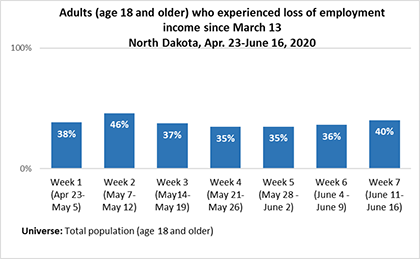
While some of the reasons for not working and losing employment income are temporary (e.g., furlough, temporary closures, illness with coronavirus), some are permanent (e.g.., laid offs and business closures). The loss of employment and employment income in a household can have various implications from not being able to purchase enough food or pay rent, to mental health issues.
Impact on food security
Food security (having access to a sufficient quantity of affordable, nutritious food to eat) is an important measure of well-being. The survey measured changes in food security by comparing the period before March 13 (pre-pandemic) to the seven days prior to completing the survey (during pandemic). About three in four adults reported having enough of the types of food they wanted to eat before the pandemic started (72% - 81%). The percentage of people that reported they had enough of the desired type of food during the pandemic are lower each week as compared to the period before the pandemic (60% - 73%).
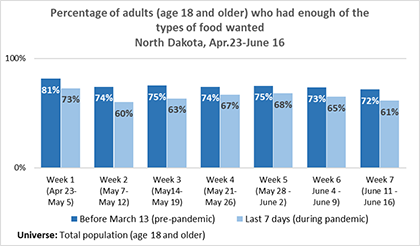
Adults who eventually lost employment income due to the pandemic, were more likely to experience food insecurity, both prior to the pandemic (50% - 78%) and during the seven-week study period (40% - 63%). Half of those who reported loss of employment income in the most recent week of the survey (June 11 - June 16) experienced food insecurity before the pandemic started. School closures and stay-at-home orders during the pandemic increased the risk for food insecurity, disproportionately affecting low-income households that already struggled to meet basic needs 1.
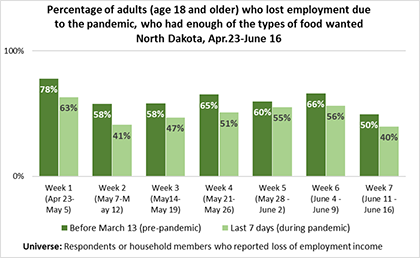
Impact on housing security
The pandemic impacted renters more than homeowners. In North Dakota, an average of 8 percent of adults (5% - 13%) in owner-occupied housing units, with a mortgage, were unable to pay their mortgage on time.
Renters were more likely to be unable to pay rent on time than homeowners. Being unable to pay rent on time the previous month was reported by an average of 16 percent of adults (10% - 22%) in renter-occupied housing units.
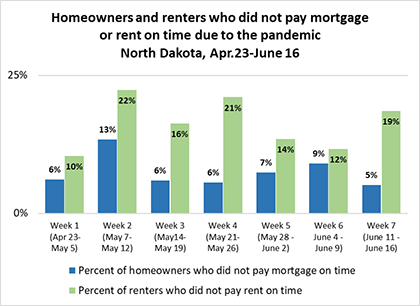
Impact on health-related issues
Anxiety and depression
Fear, uncertainty, and social isolation during the COVID-19 pandemic created stress and anxiety. Adults were asked about occurrence of symptoms of anxiety or depression over the last seven- day period. Those adults who indicated that they experienced symptoms of anxiety or depression several days to almost every day are examined below.
In North Dakota, about half of adults (48% - 56%) felt nervous, anxious or on edge over the last seven days and an average of about 42 percent (38% - 52%) declared that over the last seven days, they were bothered by not being able to stop or control worrying.
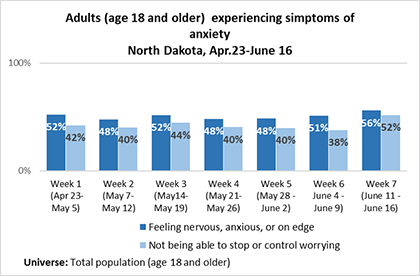
An average of about 41 percent of adults (39% - 43%) experienced symptoms of depression (i.e., having little interest or pleasure in doing things), and an average of 40 percent (37% - 45%) reported feeling down, depressed, or hopeless over the last seven days. These symptoms of anxiety or depression were consistent across the seven-week period.
According to the National Center for Health Statistics, the percentage of people who report symptoms of anxiety and depression in the Household Pulse Survey were four times higher than the percentage reported in a baseline survey used as a benchmark2.
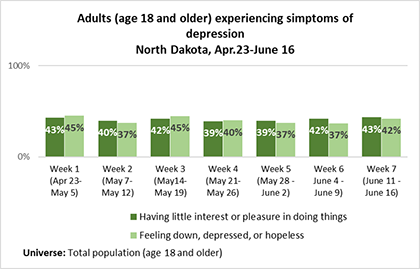
Reduced access to care
The pandemic also led to unmet needs for medical care. In general, people may delay needed medical care due to cost. As a result of the pandemic, people delayed getting medical care or were unable to get the care they needed due to cancelled appointments or procedures, reduced transportation options, fear of going to the hospital and risk infection, or the desire to not be a burden on the health system, among other reasons3.
In North Dakota, nearly a third (27% - 39%) of adults delayed getting medical care because of the COVID-19 pandemic across the seven weeks of the survey. In addition, an average of 23 percent of adults (18% - 28%) needed medical care, in the last 4 weeks, for something unrelated to COVID-19, but did not get it.
Reduced access to care is a serious impact of the pandemic since delaying medical care can result in health complications and even death4.
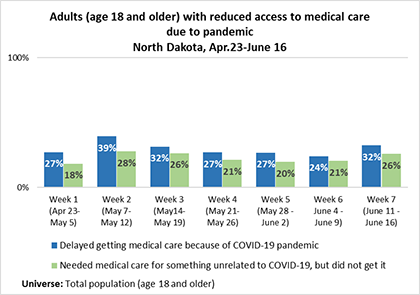
Impact on households due to educational disruptions
Households with children enrolled in public or private school (K-12) were impacted by disruptions in the education system during the COVID-19 pandemic. Due to stay-at-home orders, children were not able to attend school in person. Many school systems used alternate methods of continuing course work. According to the Household Pulse Survey, on average, about 86 percent of adults in households with children enrolled in public or private schools in North Dakota reported that classes were changed to a distance learning format using online resources. Some schools using a distance learning format, also sent home paper materials, as reported by about 27 percent of adults with children in school. About 24 percent of adults reported that classes were canceled.
In households with children enrolled in public or private school (K-12), household members spent an average of 4.1 to 16.2 hours per week, across the seven weeks of the survey, on all teaching activities with the children. The time spent with children’s educational activities decreased as time progressed and the schools approached summer break.
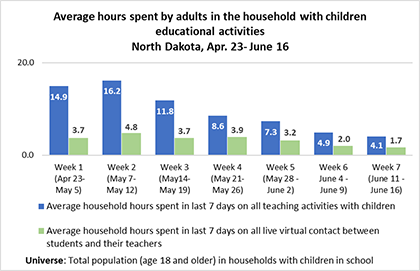
This summary offers only a very small sample of survey findings from the first seven weeks of data collection and reporting. New data is being posted every Wednesday, and provides a lot of information on the impact of COVID-19 on North Dakota’s households.
The survey provides valuable information to measure the impact of COVID-19 on employment status, food security, housing, education, and physical and mental wellness. While the effects of the pandemic regarding educational disruptions decreased as summer approached, all other impacts stayed about at the same level, week after week. The survey will continue to provide data to help measure and track how household experiences changed over time.
The Household Pulse Survey is only one of the experimental data products recently launched by the U.S. Census Bureau. Experimental data products are innovative statistical products created using new data sources or methodologies that benefit data users. Among them, the Small Business Pulse Survey measures the impact of the pandemic on small businesses. Another data product, the Community Resilience Estimates, measures the ability of a population to recover from the impacts of disasters and calculate risk levels by state, county and tract.
North Dakota Compass has compiled a comprehensive list of resources related to the COVID-19 pandemic, that is continually updated. North Dakota Compass data and additional credible data resources help inform planning, development and execution of programs, interventions and services for North Dakota’s communities during the COVID-19 pandemic.
Citations
1 J.A. Wolfson & C.W. Leung. Food Insecurity and COVID-19: Disparities in Early Effects for US Adults. Nutrients 2020, 12(6), 1648.
2 CDC, National Center for Health Statistics, Mental Health
3 CDC, National Center for Health Statistics, Reduced Access to Care
4 L. Rosenbaum. The Untold Toll — The Pandemic’s Effects on Patients without Covid-19. N Engl J Med 2020; 382:2368-2371.
Resources
U.S. Census Bureau Household Pulse Survey website
Household Pulse Survey Technical Documentation
Household Pulse Survey Questionnaire
Small Business Pulse Survey
Community Resilience Estimates
North Dakota Compass COVID-19 data resources
